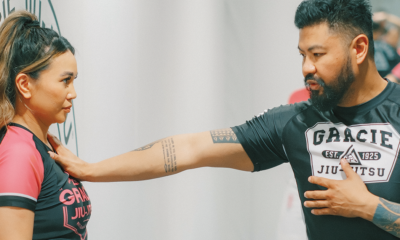Womens Self Defense
Navigating the Legal System: Understanding the Difference Between Legal and Illegal Defense Tactics

Navigating the legal system can be a daunting task for anyone, especially when it comes to understanding the difference between legal and illegal defense tactics. It is essential to have a clear understanding of what is permissible under the law in order to ensure you are properly represented and do not inadvertently engage in misconduct that could harm your case.
Legal defense tactics are strategies employed by attorneys to effectively represent their clients within the confines of the law. These tactics may involve gathering evidence, cross-examining witnesses, presenting legal arguments, and negotiating plea deals with prosecutors. Legal defense tactics are aimed at securing the best outcome for the client while adhering to ethical and legal principles.
On the other hand, illegal defense tactics involve actions that are prohibited by law and can result in severe consequences for both the client and their attorney. Examples of illegal defense tactics include tampering with evidence, suborning perjury, intimidating witnesses, and obstructing justice. Engaging in such tactics can lead to criminal charges, disbarment for attorneys, and negative repercussions for the client’s case.
It is crucial for individuals involved in the legal system to be aware of the line between legal and illegal defense tactics. By working with a reputable and ethical attorney, clients can be confident that their case is being handled in a lawful manner and that their rights are being protected.
To better understand the difference between legal and illegal defense tactics, it is important to communicate openly and honestly with your attorney. Be sure to ask questions about the strategies being employed in your case and raise any concerns you may have about potential ethical violations. Additionally, familiarize yourself with the rules of professional conduct that govern attorneys in your jurisdiction, so you can be aware of any red flags that may indicate illegal behavior.
In conclusion, navigating the legal system requires a keen understanding of the difference between legal and illegal defense tactics. By working with a knowledgeable and ethical attorney, individuals can ensure that their case is being handled in a professional and lawful manner. Remember, it is always better to play by the rules and trust in the integrity of the legal system to secure a fair and just outcome.
Womens Self Defense
The Benefits of Carrying Personal Defence Devices

Absolutely! I’m Jade Tripp, and I’m thrilled to share insights on women’s self-defense and personal protection. Let’s dive into the article!
Embracing Your Inner Strength: A Woman’s Guide to Personal Protection
In today’s world, the importance of self-defense and personal safety cannot be overstated. Every woman deserves to feel empowered and secure, whether at home, work, or out in the community. Let’s explore practical strategies and inspiring examples of women who turned their fears into strength.
Understanding the Importance of Self-Defense
Self-defense is not just about physical techniques; it’s about awareness, confidence, and preparation. Studies show that women who engage in self-defense training report lower levels of anxiety and increased feelings of empowerment.
Take the case of Karima, a woman in her early twenties who enrolled in a self-defense course after experiencing harassment on her college campus. Rather than allowing fear to dictate her life, she used it as motivation. Through training, Karima learned how to recognize threats, maintain situational awareness, and engage in physical techniques. Today, she teaches workshops, empowering other women to take control of their personal safety.
Practical Self-Defense Techniques
-
Awareness and Avoidance
- The first step in self-defense is awareness. Always be aware of your surroundings, whether you’re walking to your car at night or navigating a busy street. This awareness can help you avoid potentially dangerous situations.
-
Verbal Assertion
- Assertive communication can defuse many confrontations. Practice using a firm voice to set boundaries. For instance, if someone invades your personal space, don’t hesitate to say, “Back off!” This can deter an aggressor and give you a moment to escape.
-
Physical Techniques
- While every situation is unique, certain techniques can help disarm an attacker. Techniques like the palm strike or knee to the groin can create an opportunity for escape. Enroll in a local class—many gyms and community centers offer women-only self-defense courses where you can practice these skills in a supportive environment.
For example, Maya, a community member who faced a frightening encounter while jogging, used a self-defense move she had learned during a workshop. By striking her attacker and escaping, she emerged with newfound courage and a determination to mentor other women.
Advocacy and Support Systems
Don’t underestimate the power of community. Forming a support network with friends can enhance your security. Whether it’s arranging a buddy system when going out or sharing self-defense tips, mutual support strengthens bonds and comfort levels.
Consider joining local groups or organizations focused on women’s safety—like She’s Brave, which provides workshops and training sessions tailored for women. Their founder, Sarah Lopez, turned her painful history into activism, ensuring women in her community are well-equipped to protect themselves.
Resources to Empower Yourself
-
Self-Defense Classes: Local community centers, YMCAs, or martial arts studios often offer self-defense classes tailored for women. Check out websites or social media pages to see if there are upcoming sessions near you.
-
Apps and Tools: Many personal safety apps, like bSafe or SafeTrek, allow you to alert friends or the authorities in emergencies. Explore these apps and choose one that fits your lifestyle.
- Books and Online Courses: Resources like “The Gift of Fear” by Gavin de Becker can provide deeper insights into intuition and personal safety.
Conclusion: Your Safety, Your Power
Every woman has the right to feel safe and empowered—self-defense is a crucial step in claiming that right. Remember, you are not alone on this journey. Learn from the experiences of others, seek help when needed, and never hesitate to share your story. Together, we can create a future where every woman feels confident, safe, and strong.
Let’s embrace our inner warriors—after all, we’re capable of more than we know!
I hope this article resonates and inspires you. Remember, a little knowledge and preparation can go a long way in enhancing your safety and confidence! Stay strong, beautiful women!
Womens Self Defense
Women’s self-defense 46 | fake situation #tonytam #shorts #action #selfdefense #entertainment

Women’s self-defense 46 | fake situation #tonytam #shorts #action #selfdefense #entertainment This video is a reenactment of …
source
Womens Self Defense
Arming Women with Knowledge: The Importance of Legal Defense Courses

In today’s society, self-defense is not merely about physical prowess; it’s also about understanding the law and one’s rights. Legal defense courses have emerged as a vital tool for women to empower themselves, equipping them with both knowledge and skills essential for navigating legal challenges in high-stress situations. Here’s why these courses are critical for women.
Understanding Legal Rights
The Foundation of Self-Defense
Legal self-defense is defined by parameters that vary from state to state. Women must understand what constitutes justifiable self-defense under the law. A legal defense course offers insights into:
- Allowed Actions: What actions can be legally taken when defending oneself.
- Duty to Retreat: Whether one is required to attempt to escape a situation before resorting to physical defense.
- The Importance of Documentation: Knowing how to report incidents correctly and gather evidence.
Navigating Complex Legal Landscapes
Situations involving self-defense can quickly become legal quagmires. Knowing when and how to involve law enforcement can significantly affect the outcome of any legal proceedings. Legal defense courses prepare women to handle these situations with the knowledge necessary to protect themselves and minimize legal repercussions.
Empowerment through Education
Building Confidence
Knowledge breeds confidence. Women who take legal defense courses often report feeling more empowered in their daily lives. Understanding their rights and the law allows them to approach potentially dangerous situations with a sense of agency rather than fear.
Combating Stereotypes
Arming women with legal knowledge helps counteract stereotypes that often view women as victims rather than assertive individuals capable of self-advocacy. By fostering a community that prioritizes education, we encourage the perception of women as empowered individuals who are equipped to handle their safety.
Holistic Self-Defense
Mind, Body, and Law
True self-defense encompasses physical skills, mental preparation, and legal knowledge. Courses can integrate self-defense techniques with legal education, ensuring that participants leave not only with the ability to protect themselves physically but also with an understanding of the consequences their choices may have on a legal level.
Scenario-Based Learning
Many legal defense courses incorporate scenario-based learning, where participants confront carefully crafted situations to practice both self-defense and legal decision-making. This hands-on approach helps women think critically about their responses in real-life circumstances.
Building Community
Support and Solidarity
Women’s legal defense courses often foster a sense of community, allowing participants to share experiences and support one another. This camaraderie can be an invaluable aspect of the learning process, creating networks of women who stand in solidarity.
Encouraging Advocacy
Women who are armed with legal knowledge are more likely to advocate for themselves and others. They can become voices for change, urging legal reforms that protect women and promote safety in communities. Educated women can also mentor others, multiplying the impact of their knowledge.
Conclusion
Arming women with legal knowledge through defense courses is essential for fostering empowerment, confidence, and self-advocacy. By understanding their rights and the legal implications of their choices, women can navigate potentially dangerous situations more effectively. These courses not only prepare women to defend themselves physically but also equip them with the tools to protect their rights in a complex legal landscape. In a world where knowledge truly is power, legal defense courses represent a crucial step toward a safer, more equitable society.
-

 Womens Self Defense9 months ago
Womens Self Defense9 months agoNew Legislation Empowers Women to Defend Themselves
-

 Self Defense News1 year ago
Self Defense News1 year agoShe was convicted of killing her abusive boyfriend. Now a Maple Grove woman is home awaiting a new trial.
-

 Self Defense News1 year ago
Self Defense News1 year agoSelf-Defense for All: The new Gracie Jiu-Jitsu Pasadena is for everyone | Online Features
-

 Womens Fitness1 year ago
Womens Fitness1 year agoXtreme Bodyweight HIIT (Lots of Jumping!) | Joanna Soh (Fio Series)
-

 Womens Self Defense1 year ago
Womens Self Defense1 year agoTop 5 Self-Defense Techniques Every Woman Should Know
-

 Womens Self Defense6 months ago
Womens Self Defense6 months agoUnderstanding State-by-State Variation in Self Defense Laws
-

 Womens Preparedness1 year ago
Womens Preparedness1 year ago10 essential skills for surviving in the great outdoors
-

 Self Defense News1 year ago
Self Defense News1 year agoBRPD offering free self-defense classes for women



